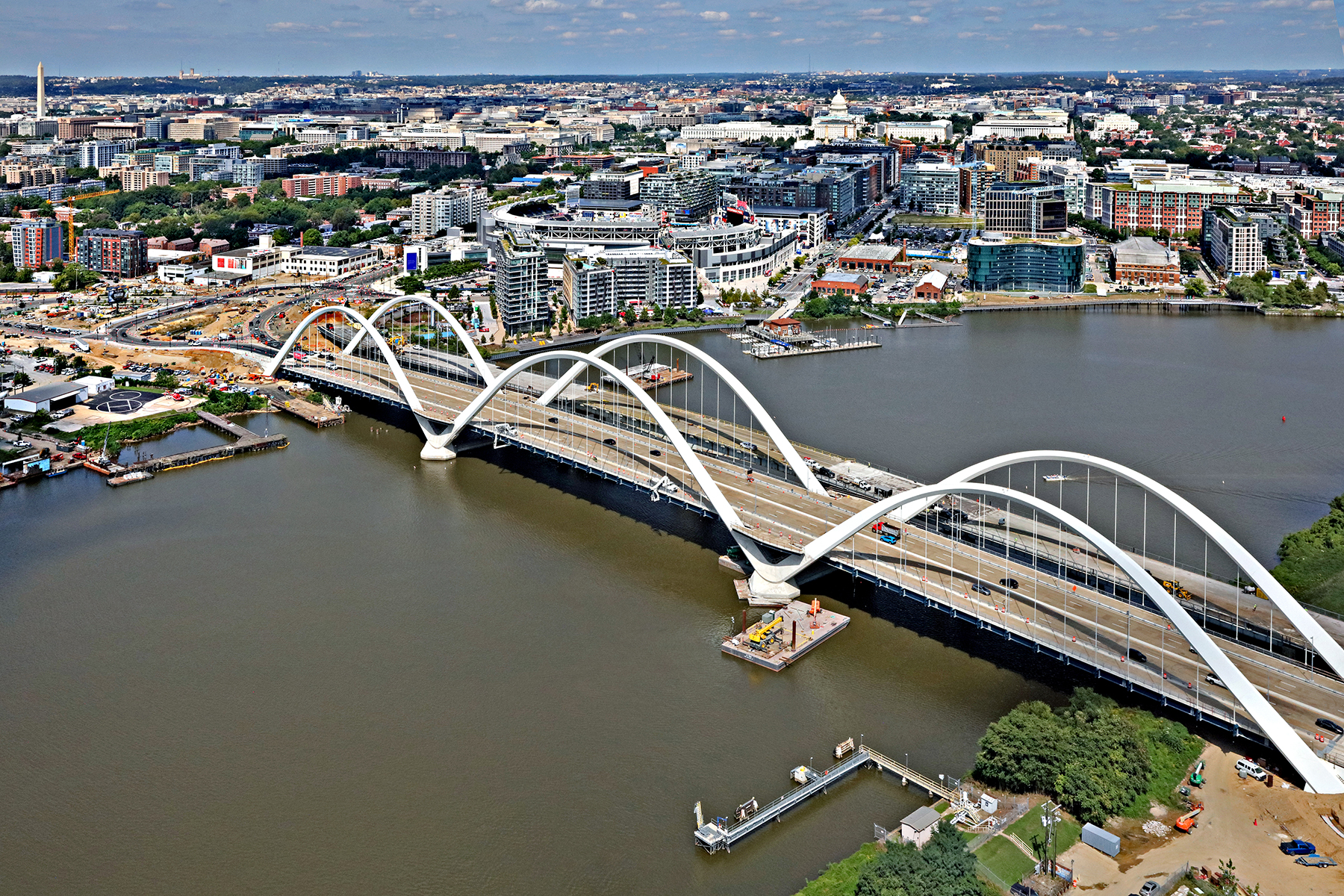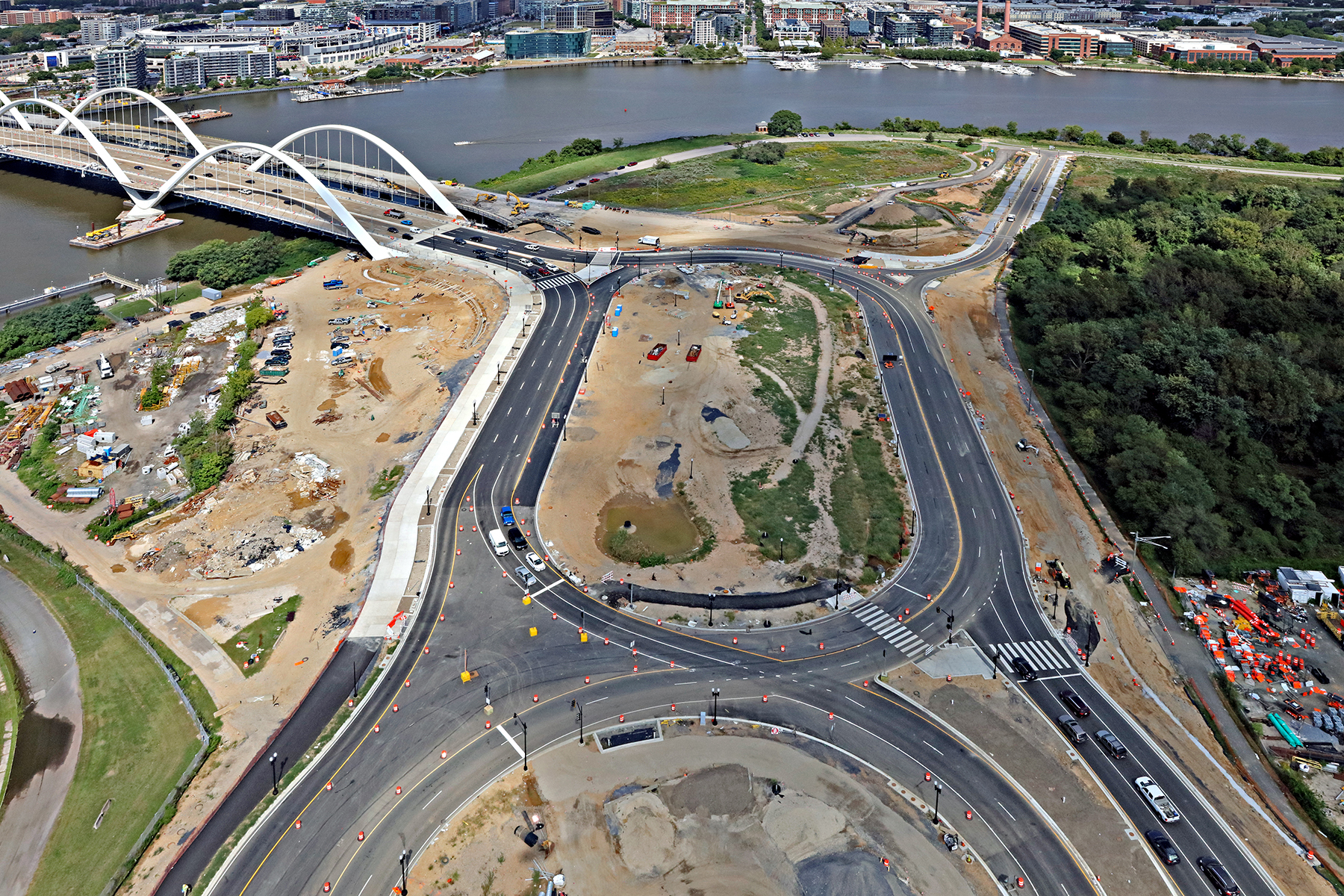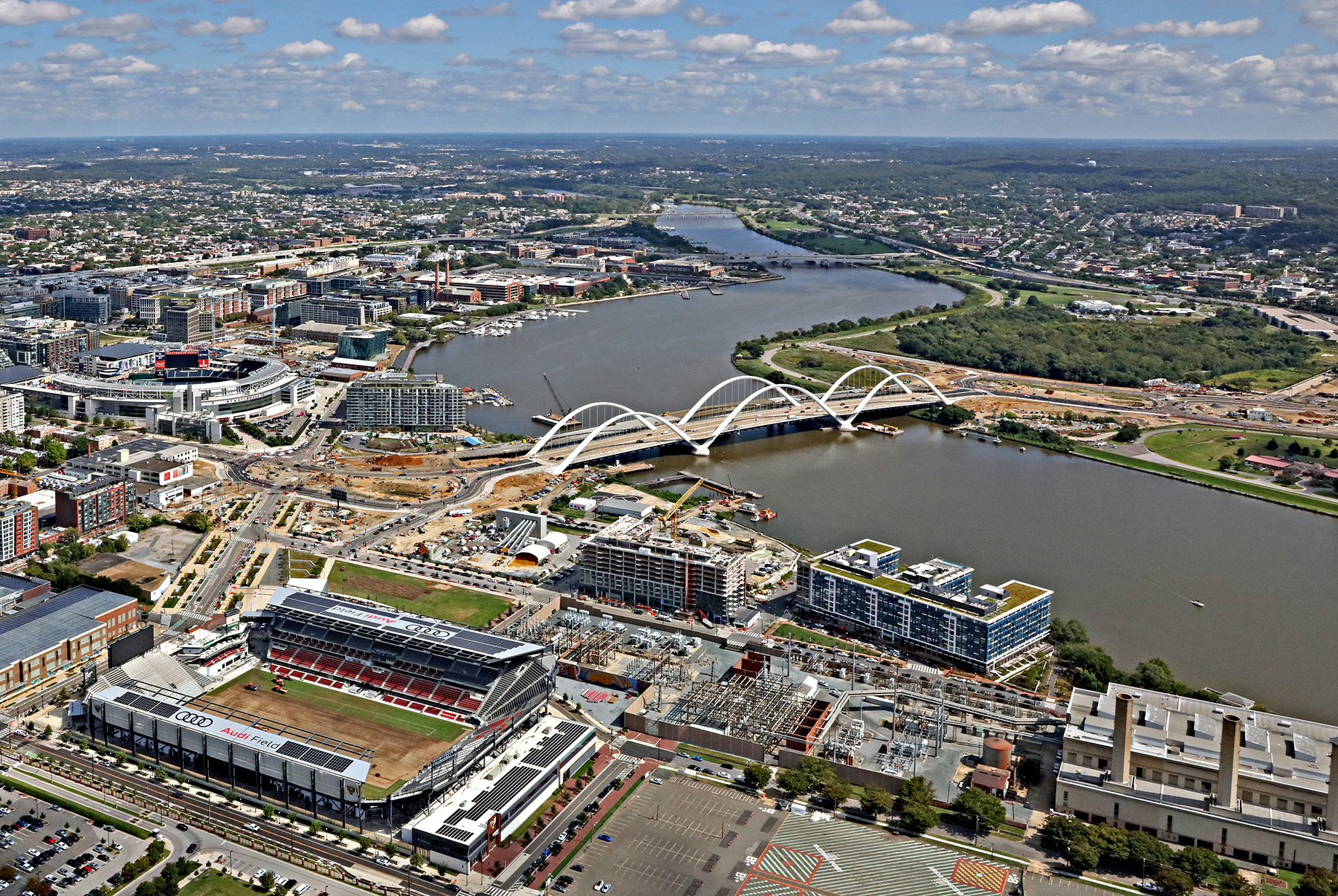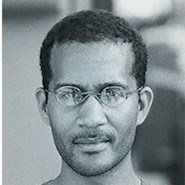By T.R. Witcher
Washington, D.C., may not be the first American city that comes to mind when you think of historic bridges — perhaps it’s the iconic bridges of New York, San Francisco, or even Pittsburgh — but many understated, elegant structures span the Potomac River, including the Arlington Memorial Bridge and the Francis Scott Key Bridge. In recent years the Anacostia River, which bisects the city south and east of downtown before joining with the Potomac River, has become a focal point of redevelopment in the city. In early September, the city opened what it hopes will be considered a new signature bridge: the Frederick Douglass Memorial Bridge, a 1,445 ft crossing that features a dramatic through-arch design containing three arches.

The original bridge, the South Capitol Street Bridge, was built in 1950 and renamed in honor of 19th-century abolitionist Frederick Douglass in 1965. The life span of the four-lane swing bridge was planned to be 50 years, but in 2007 it was rehabilitated to extend its life span by approximately 15 years to accommodate construction of a new crossing.
Seventy years after its construction, the original bridge — which saw upward of 77,000 commuters a day — was considered structurally deficient and functionally obsolete with substandard pedestrian and cycling lanes. The crossing “was definitely in need of an overhaul,” says Everett Lott, the acting director of the District Department of Transportation.
Reviving the riverfront
The new bridge, which was built adjacent to the original one, upgrades the infrastructure for users. It has been designed with a 100-year life span and features three lanes of traffic in each direction instead of the original bridge’s two. It also offers 18 ft wide cycling and pedestrian lanes, rather than the much narrower 6 ft sidewalks of the old bridge. Four pedestrian overlooks (two on each side of the bridge) provide expansive views of the District and the redeveloping Anacostia waterfront.
The bridge is the centerpiece of a much larger redevelopment. DDOT is also overseeing the construction of traffic ovals on the west and east sides of the bridge — to help calm and optimize traffic throughput, serve as community gathering spaces, and heighten the gateway character of the bridge. And on the southeastern riverbank, a riverfront esplanade will carry pedestrians under the bridge, linking to a park and the city’s extensive trail network. Portions of South Capitol Street will also be rebuilt as will portions of Suitland Parkway and its interchange with Interstate 295. This additional work should be complete by summer.

Overall, the $441 million project is designed to improve bridge safety and make it multimodal — by connecting to D.C.’s extensive bike trail network — and transform South Capitol Street into a grand urban boulevard. The bridge is also expected to encourage development on both sides of the river. (The north side of the river has already seen tremendous growth; the bridge is just a few blocks from Audi Field, a pro soccer stadium that is home to Major League Soccer’s D.C. United, and Nationals Park, home to Major League Baseball’s Washington Nationals).
The old bridge is being demolished. The process will take 4-5 months and is expected to be complete in February.
Designing an icon
Planning on the new bridge has been underway since 2003 with construction beginning in 2018. When selecting the design for the new bridge, transportations officials knew it had to make a statement. “To build a bridge in (the) heart of (the) city, we wanted to make sure it had a visual quality standard that would meet or exceed expectations of users and would make the Anacostia River itself a destination,” says Joe Dorsey, the deputy program manager for the South Capitol Street Corridor Project.
DDOT set several design goals for the building team, led by the project’s design-build contractor, a consortium known as South Capitol Bridgebuilders, and the firm that designed the bridge, AECOM. One was to transform the South Capitol Street Corridor. Another was to create “an elegant and iconic new bridge which reflects the classical repose of Washington’s monumental bridges and is grounded in the traditions of great civic design in Washington, D.C.” A third was to “develop a gateway to the city’s monumental core which celebrates the passage across the river from the metropolitan region and the hills of the Anacostia into the historic L’Enfant street pattern of Washington, D.C., and to the U.S. Capitol.”
Dorsey says that sense of “classical repose” is found in the way many D.C. bridges have arches entirely beneath their decks. “We wanted to have something that reflected the same type of iconic view,” he says.

The bridge features three white arches that gently dip below the bridge deck to land on two piers, which appear to float in the middle of the river. The arches read visually almost like arcing jets of water in a water fountain, springing off these piers. The bridge, says Lott, was meant to create a “visual effect of continuity and flow from the deck to the water surface.”
According to engineering firm Systra IBT, which served as the independent checking engineer on the project, the bridge deck is 122.5 ft wide but extends as wide as 166 ft at the pedestrian overlook locations. The bridge’s arches are, according to the firm’s website, "longitudinally stiffened steel box shapes and are laterally unsupported” with “no transverse bracing between arches.”
“The steel arches are supported on post-tensioned concrete substructures and steel pipe pile foundations,” according to Systra. “Interior piers have a V shape. The composite deck comprises precast panels on built-up I-shaped edge girders and floor beams. The deck is suspended from the steel arches with vertical hangers.”
Unlike the old bridge, the new bridge is not movable. DDOT conducted a study to determine the current and planned navigation along the Anacostia River, including the navigation needs of the U.S. Navy. The study, according to the department, “determined that 99.8% of the current and projected vessel traffic on the Anacostia River could be accommodated by a fixed bridge with 42 ft of vertical clearance.”
Challenging placement
The geometry of those cast-in-place, V-shaped piers made casting the concrete difficult. Normally concrete is placed vertically or horizontally, Dorsey explains. “Generally, placement of concrete horizontally means that a large open area is cast, allowing full access to the forms, reinforcing steel, and surface area, which better facilitates concrete consolidation through vibration of the concrete. Vertically placing concrete — typically using a chute or tremie system — requires more formwork, less access to the full height of the placement, and less access for vibratory consolidation.”
In this case, the South Capitol Bridgebuilders used an intricate V-Pier shape formwork that was heavily reinforced and had limited access for vibratory consolidation. Workers thus had to vibrate the concrete very exactingly — and they couldn't place it too fast or too slowly. Some concrete spalling on the first pier placement sent workers back to check the mix design, the rate of placement, how fast they were vibrating the concrete, and how they were curing it. As they were placing concrete, small samples could be tested; if there was a problem, engineers would let the concrete set, saw-cut and remove bad portions, and then recast. The work took 2-3 months, and many of the placements took place at night with concrete trucks operating from one of the lanes of the original bridge, which had been closed.
Initially a standard concrete mix was used for the placements, but the mix design was revised to a “self-consolidating” mix to improve workability and reduce the need for access to vibratory consolidation, which greatly improved the concrete finish in these large intricate piers. And that attention to detail paid off: “We did get it right,” Dorsey says. “When we went to set the (56) arch pieces — because the concrete was poured correctly and all the design criteria were met — … it went in like Lego pieces. Everything fit with no major adjustments.”
The new bridge will also be friendlier to the environment than the original bridge was. Because that crossing was movable, it had metal grates on the deck. So when DDOT treated the bridge for snow or ice in the winter, salt or other chemicals would eventually run off directly into the Anacostia River. The new bridge will capture stormwater runoff and sediment and direct it to the city’s combined sewer overflow system.
“We believe we have made a statement,” says Lott. “The district is known for its monuments, and this is another monument that we will feel will generate a lot of excitement and energy and attract a lot of different users.”



